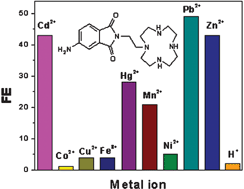The fluorescence response of two fluorophore–spacer–receptor systems, 1 and 2, wherein a 4-aminophthalimido moiety is linked to a monoaza- and a tetraazacrown macrocycle via a dimethylene spacer, has been explored in the absence and in the presence of various transition and post transition metal ions. Unlike the parent fluorophore, these systems are weakly fluorescent because of photoinduced electron transfer (PET) between the terminal moieties of the molecules. Of the two systems, PET is found to be more efficient in 2, which contains the tetraazacrown moiety as the receptor. Both systems display complex fluorescence decay behaviour with the average fluorescence lifetime much shorter than that of the parent fluorophore. The systems exhibit fluorescence enhancement in the presence of the metal ions, some of which are notorious quenchers of fluorescence. While the fluorescence output of 1 is rather similar with different metal ions, 2 exhibits high fluorescence enhancement with metal ions such as Zn2+, Cd2+, Pb2+, Hg2+ and Mn2+ while producing negligible enhancement with the remaining metal ions studied. This specific signaling behaviour of 2 has been rationalized taking into consideration somewhat unusual binding ability of the tetraazacrown receptor moiety.

You have access to this article
 Please wait while we load your content...
Something went wrong. Try again?
Please wait while we load your content...
Something went wrong. Try again?


 Please wait while we load your content...
Please wait while we load your content...